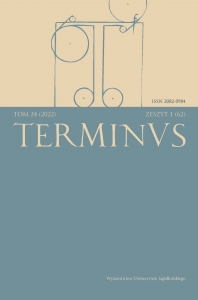Finis Ianitii? Mikołaj Lubomirski’s supplementum to Klemens Janicki’s Vitae regum Polonorum
“Finis Ianitii? Mikołaj Lubomirski’s supplementum to Klemens Janicki’s Vitae regum Polonorum”
Author(s): Patryk Michał RyczkowskiSubject(s): Studies of Literature, Modern Age, Theory of Literature
Published by: Wydawnictwo Uniwersytetu Jagiellońskiego
Keywords: Klemens Janicki; Mikołaj Lubomirski; supplement; vitae; epigram; Poland-Lithuania; Jagiellonians;
Summary/Abstract: This contribution provides an edition of Mikołaj Lubomirski’s epigrams on Polish-Lithuanian rulers. It consists of three major parts. Firstly, a preliminary study establishes the connection between Janicki’s vitae and Lubomirski’s work. Janicki’s vitae were written around 1542 and printed as late as 1563. Many subsequent editions and Polish paraphrases introduced changes, such as the pieces on the rulers who were not covered by Janicki. A few examples of such additions (for example, two versions of Andrzej Trzecieski’s epigram) and of Janicki’s vitae editions (Gdańsk 1621, Kraków 1631, Stendal 1670) are discussed. Between 1621 and 1632, Lubomirski composed four additional (Latin) epigrams, which he included in a notebook that is partially preserved in: Kraków, Biblioteka Jagiellońska, ms. 5575 (codex unicus). The poems are collected in a separate unit (supplementum) and placed directly after the handwritten copy of Janicki’s vitae. It is argued that Lubomirski aimed to reveal the theme of Jagiellonian succession, mostly through the symmetrical composition of his cycle. Its framework is constituted by the first and the last epigram on the figures who are connected to the Jagiellonian dynasty, Sigismund II Augustus (supp. I) and Sigismund III Vasa (supp. IV). Within this arrangement, the second and the third poems are devoted to the first kings elected in the so-called free election, Henri de Valois (supp. II) and Stephen Báthory (supp. III). Both pieces contrast with each other, however: Henry’s image is clearly negative, while Stephan is depicted overall positively, and thus his profile is similar to those of Jagiellonians. Other intersections between the poems, which exceed the frame and inset composition, can be observed as well. After the critical edition of Lubomirski’s epigrams (second part) the commentary (third part) is structured not according to the chronology of the rulers, but in order to acknowledge the established theme of Jagiellonian succession. In addition to a few textual and philological issues, the commentary notes internal connections between the pieces in the supplementum. Some essential similarities and differences to other vitae cycles and texts are remarked, although the focus is on Janicki’s epigrams. Finally, the historical context is explained and the events, places, and figures that the poems refer to are identified.
Journal: TERMINUS
- Issue Year: 24/2022
- Issue No: 1 (62)
- Page Range: 55-91
- Page Count: 37
- Language: English

